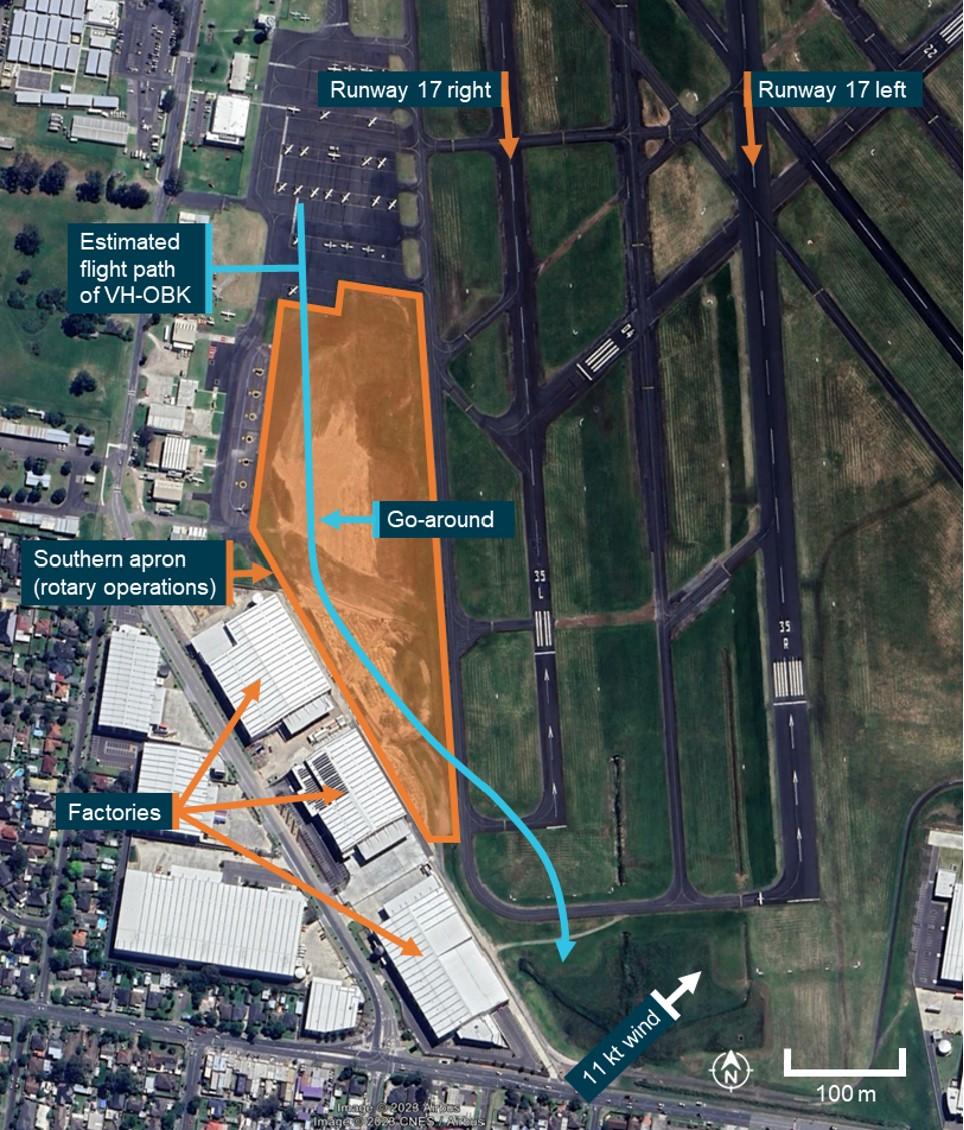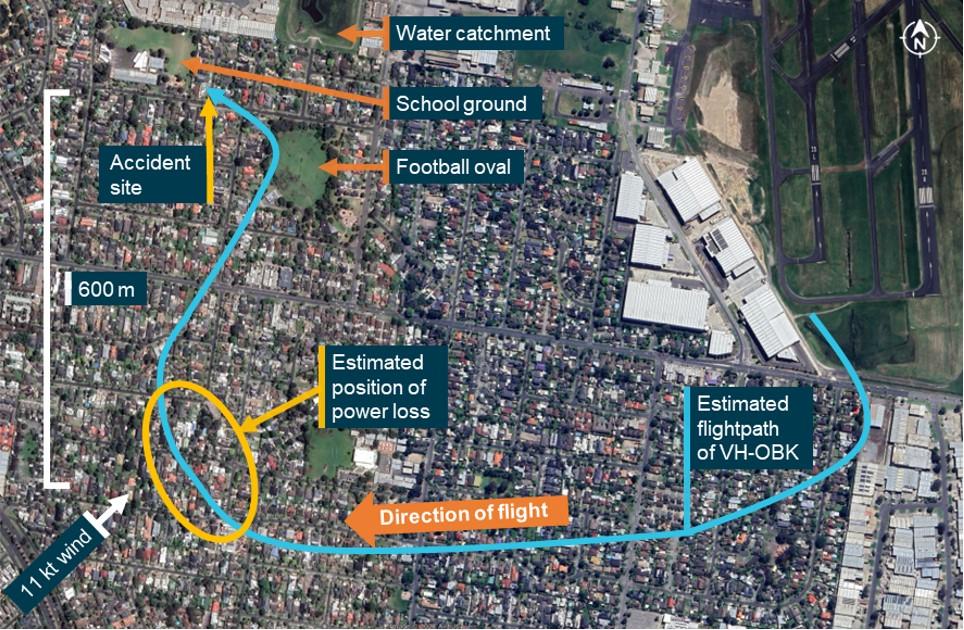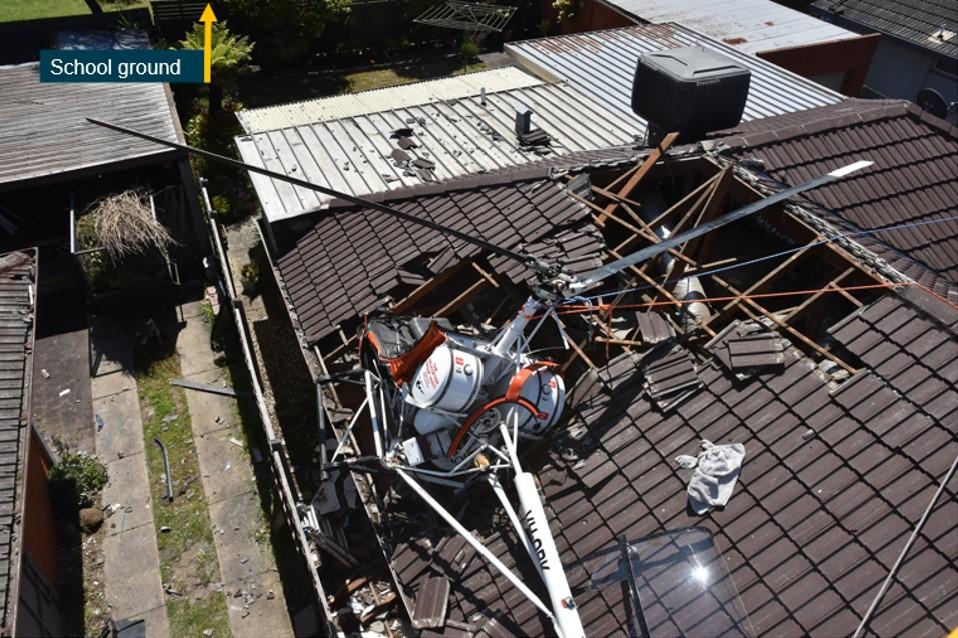What happened
On the afternoon of 30 November 2022, the student pilot of a Hughes Helicopters 269C, registered VH-OBK, was returning to Moorabbin following the pilot’s second solo navigation training flight.
As the helicopter approached the landing area, the approach became unstable, and the pilot commenced a go‑around. As the helicopter climbed to about 650 ft above ground level, the pilot commenced a right turn onto the downwind leg of the circuit to position for a second approach for landing. Shortly after, the pilot noticed reduced performance and decided to continue the turn back toward the airport.
The helicopter continued to lose height and, recognising that a forced landing was required, the pilot turned the helicopter left toward a school ground to attempt an autorotation landing. The helicopter subsequently collided with the rooftops of 2 houses just short of the school ground. The pilot sustained serious injuries and the helicopter was substantially damaged.
What the ATSB found
The ATSB found that as the helicopter climbed to about 650 ft above ground level, the engine lost power. The reason for the engine power loss was not determined.
The power loss was not immediately recognised which limited the opportunities for a safe forced landing. During the forced landing, the helicopter did not have sufficient height to reach the selected landing area and collided with rooftops.
Safety message
This accident highlights the challenges pilots face when confronted with a loss of engine power at low level and with few suitable landing areas available.
Pilots can best mitigate the effects of a power loss by forward planning, which reduces your mental workload under stress. The Civil Aviation Safety Authority Advisory Circular Guidelines for helicopters -suitable places to take off and land recommends:
…before conducting a take-off from any aerodrome, pilots of single-engine helicopters make themselves aware of the areas that would be suitable, from the lift-off point to a safe manoeuvring height, to conduct a forced landing in the event of engine failure after take-off.
These challenges of managing a power loss are increased for an inexperienced student pilot. While in this case, the selected landing location was unable to be reached, importantly, the pilot maintained control of the helicopter to maximise survivability.
The investigation
The occurrence
The navigation exercise was conducted without incident and at 1255, the helicopter returned to Moorabbin where air traffic control provided the pilot with clearance to conduct a visual approach to the southern apron.
At 1300, the helicopter approached the apron to land. At a height of about 20 ft above ground level (AGL), the approach became unstable, and the pilot accelerated the helicopter slightly to stabilise the approach. The acceleration moved the helicopter further along the apron where the pilot judged that insufficient space remained to conduct a safe landing so they commenced a go‑around.
During the go-around, the pilot observed factories located immediately south of the apron and made a left turn, opposite to the right circuit direction, to provide sufficient room to climb over the factories (Figure 1). This left turn unintentionally took the helicopter toward the departure path of the active runway 17 right, and air traffic control instructed the pilot to make an immediate right turn. The pilot turned the helicopter right and continued climbing on the crosswind leg of the circuit.
Figure 1: Go-around flight path of VH-OBK (Moorabbin airport)

Source: Google Earth, annotated by the ATSB
As the helicopter climbed to about 650 ft AGL, the pilot commenced a right turn onto the downwind leg of the circuit.[1] During the turn, the pilot noted reduced helicopter performance and decided to continue the right turn to take the helicopter back toward the airport.
The pilot recalled that there were no unusual engine sounds or vibrations but that regular communications between air traffic control and other aircraft limited their ability to hear the engine. The pilot reviewed the instrumentation to attempt to identify a reason for the performance loss. The pilot observed the helicopter’s airspeed had increased from the climb speed of 55 kt to between 70‑80 kt and that the manifold pressure had increased above the targeted 24 inches of mercury (Hg) to 29 inches Hg. The engine RPM reading was not checked.
The pilot then adjusted the pitch attitude of the helicopter to that which normally provided a climb speed of 55 kt and lowered the collective[2] slightly to reduce the observed high manifold pressure reading. Following these actions, the helicopter continued descending as it tracked toward the airport.
As the aircraft descended to about 100 ft AGL, the pilot recognised that the descent rate had increased, and a forced landing was required. At that time, a football oval was likely positioned under or slightly ahead and to the right of the helicopter, but the pilot did not see it possibly because it was obscured by the airframe or instrument panel. The pilot identified a water catchment and a school ground as suitable areas for a forced landing and turned the helicopter left toward the school ground to attempt an autorotation[3] landing (Figure 2). The helicopter did not have sufficient height to reach the school ground and collided with the rooftops of 2 houses. The pilot sustained serious injuries and the helicopter was substantially damaged.
Figure 2: Flight path of VH-OBK

Source: Google earth, annotated by the ATSB
Context
Meteorology
A meteorological report for Moorabbin Airport, recorded at 1300, included a south-westerly wind of 11 kt, visibility greater than 10 km, no cloud, a temperature of 17 °C, and a mean sea level air pressure of 1,018 hectopascals.
The estimated air pressure at 650 ft above mean sea level (600 ft AGL) was 996 hectopascals (29.4 inches Hg).[4]
Aircraft details
VH-OBK was a 3-seat Hughes Helicopters 269C helicopter, manufactured in 1980. The helicopter was powered by a 190 horsepower Textron Lycoming HIO-360-D1A, four-cylinder, fuel injected piston engine. Engine power was transmitted via a belt drive transmission to the main transmission and tail rotor drive shaft. The belt drive assembly incorporated an overrunning clutch to permit autorotation without driving the belts or engine.
The helicopter was not fitted with a low rotor RPM aural warning system, nor was it required to be.
Using information provided by the aircraft operator, the ATSB calculated that the autorotative range from 650 ft AGL was about 0.26 nm (490 m) with no wind and about 0.32 nm (590 m) with a 11 kt south-westerly tail wind.
Site and wreckage information
The helicopter impacted 2 houses immediately adjacent to the school ground targeted for the forced landing (about 600 m from the estimated position of the power loss). The helicopter came to rest embedded in the roof of one of the houses. After recovery of the wreckage, an inspection of the helicopter’s fuel tanks found at least 60 litres of fuel on board.[5]
Figure 3: Accident site

Note: The forward section of the fuselage was cut away by first responders to facilitate removal of the pilot.
Source: Victoria Police, annotated by the ATSB
A detailed examination of the airframe or engine was not performed. However, a visual inspection of the engine cooling fan and fan shroud indicated that the engine was not running at the time of the accident. The degree of damage to the rotor blades also indicated that the engine was providing little or no power.
Witness information
Two Moorabbin air traffic controllers observed the accident. One was located within the control tower, and the other was on a break, walking about 650 m north-east of the accident site. The controller on break noted that prior to the accident, the helicopter’s descent path was shallower than that of a normal autorotation and no engine noise was heard. The controller in the tower also noted the shallow descent path.
Safety analysis
The shallower‑than‑expected descent profile observed by the witnesses familiar with the helicopter’s autorotative descent profile, may have been due to the beneficial effect of the pilot pitching the helicopter up to reduce the airspeed from 70‑80 kt to the target airspeed of 55 kt. After the accident, a visual inspection of the engine cooling fan and shroud identified no rotational damage, similarly indicating that the engine was not running at the time of the accident.
There were no reported actions made that may have led to the power loss and the helicopter had sufficient fuel on-board. There were no other reported indications of a fault with the engine. A detailed examination of the engine and airframe was not performed, limiting the ability to identify the reason for the power loss.
The engine power loss occurred at low height over a densely populated area presenting a challenging scenario for the inexperienced student pilot. The pilot did not immediately identify that power was lost and attempted to return to the airport while troubleshooting the reduced helicopter performance. During this time, the helicopter passed 2 suitable forced landing sites (Figure 4).
Figure 4: Flight path of VH-OBK following the engine power loss

Source: Google Earth, annotated by the ATSB
When the pilot recognised that a forced landing was required, the football oval was likely the closest suitable area, but the pilot did not identify the oval, possibly due to it being obscured by the airframe or instrument panel. The pilot identified the school ground and attempted a landing there. However, the helicopter did not have sufficient height to reach the selected site and the helicopter collided with rooftops. While the helicopter did not reach the intended area, the pilot maintained sufficient control of the helicopter and rotor RPM to conduct an autorotation landing into the rooftops, which maximised survivability.
Findings
|
ATSB investigation report findings focus on safety factors (that is, events and conditions that increase risk). Safety factors include ‘contributing factors’ and ‘other factors that increased risk’ (that is, factors that did not meet the definition of a contributing factor for this occurrence but were still considered important to include in the report for the purpose of increasing awareness and enhancing safety). In addition ‘other findings’ may be included to provide important information about topics other than safety factors. These findings should not be read as apportioning blame or liability to any particular organisation or individual. |
From the evidence available, the following findings are made with respect to the collision with terrain involving Hughes Helicopters 269C, VH-OBK near Moorabbin Airport, Victoria on 30 November 2022.
Contributing factors
- As the helicopter climbed to about 650 ft above ground level, the engine lost power. The reason for the power loss was not determined.
- The power loss was not immediately recognised which limited the opportunities for a safe forced landing. During the forced landing, the helicopter did not have sufficient height to reach the selected landing area and collided with rooftops.
Sources and submissions
Sources of information
The sources of information during the investigation included the:
- pilot of the accident flight
- pilot’s instructor
- operator
- Airservices Australia
- Bureau of Meteorology
- aircraft manufacturer
- air traffic controllers
- video footage of the accident flight.
References
Civil Aviation Safety Authority 2022, Advisory Circular AC 91-29 v1.1 Guidelines for helicopters -suitable places to take off and land, July 2022.
Submissions
Under section 26 of the Transport Safety Investigation Act 2003, the ATSB may provide a draft report, on a confidential basis, to any person whom the ATSB considers appropriate. That section allows a person receiving a draft report to make submissions to the ATSB about the draft report.
A draft of this report was provided to the following directly involved parties:
- operator
- pilot’s instructor
- pilot
- air traffic control witnesses.
Submissions were received from the:
- operator
- pilot’s instructor
- pilot.
The submissions were reviewed and, where considered appropriate, the text of the report was amended accordingly.
Purpose of safety investigationsThe objective of a safety investigation is to enhance transport safety. This is done through:
It is not a function of the ATSB to apportion blame or provide a means for determining liability. At the same time, an investigation report must include factual material of sufficient weight to support the analysis and findings. At all times the ATSB endeavours to balance the use of material that could imply adverse comment with the need to properly explain what happened, and why, in a fair and unbiased manner. The ATSB does not investigate for the purpose of taking administrative, regulatory or criminal action. TerminologyAn explanation of terminology used in ATSB investigation reports is available here. This includes terms such as occurrence, contributing factor, other factor that increased risk, and safety issue. Publishing informationReleased in accordance with section 25 of the Transport Safety Investigation Act 2003 Published by: Australian Transport Safety Bureau © Commonwealth of Australia 2023
Ownership of intellectual property rights in this publication Unless otherwise noted, copyright (and any other intellectual property rights, if any) in this report publication is owned by the Commonwealth of Australia. Creative Commons licence With the exception of the Coat of Arms, ATSB logo, and photos and graphics in which a third party holds copyright, this publication is licensed under a Creative Commons Attribution 3.0 Australia licence. Creative Commons Attribution 3.0 Australia Licence is a standard form licence agreement that allows you to copy, distribute, transmit and adapt this publication provided that you attribute the work. The ATSB’s preference is that you attribute this publication (and any material sourced from it) using the following wording: Source: Australian Transport Safety Bureau Copyright in material obtained from other agencies, private individuals or organisations, belongs to those agencies, individuals or organisations. Where you wish to use their material, you will need to contact them directly. |
[1] The altitude for the downwind leg of the circuit for helicopters at Moorabbin Airport was 700 ft above mean sea level (650 ft AGL).
[2] Collective: a primary helicopter flight control that simultaneously affects the pitch of all blades of a lifting rotor. Collective input is the main control for vertical velocity.
[3] Autorotation is a condition of descending flight where, following engine failure or deliberate disengagement, the rotor blades are driven solely by aerodynamic forces resulting from rate of descent airflow through the rotor. The rate of descent is determined mainly by airspeed.
[4] The International Standard Atmosphere (ISA) provides hypothetical standard temperatures and pressures at specified altitudes. ISA conditions are used as a datum for calculating aircraft performance data. The ISA states that air pressure reduces by 1 hectopascal for each 30 ft increase in altitude.
[5] The helicopter was fitted with a main and auxiliary fuel tank. These tanks were interconnected and acted as one fuel tank.


